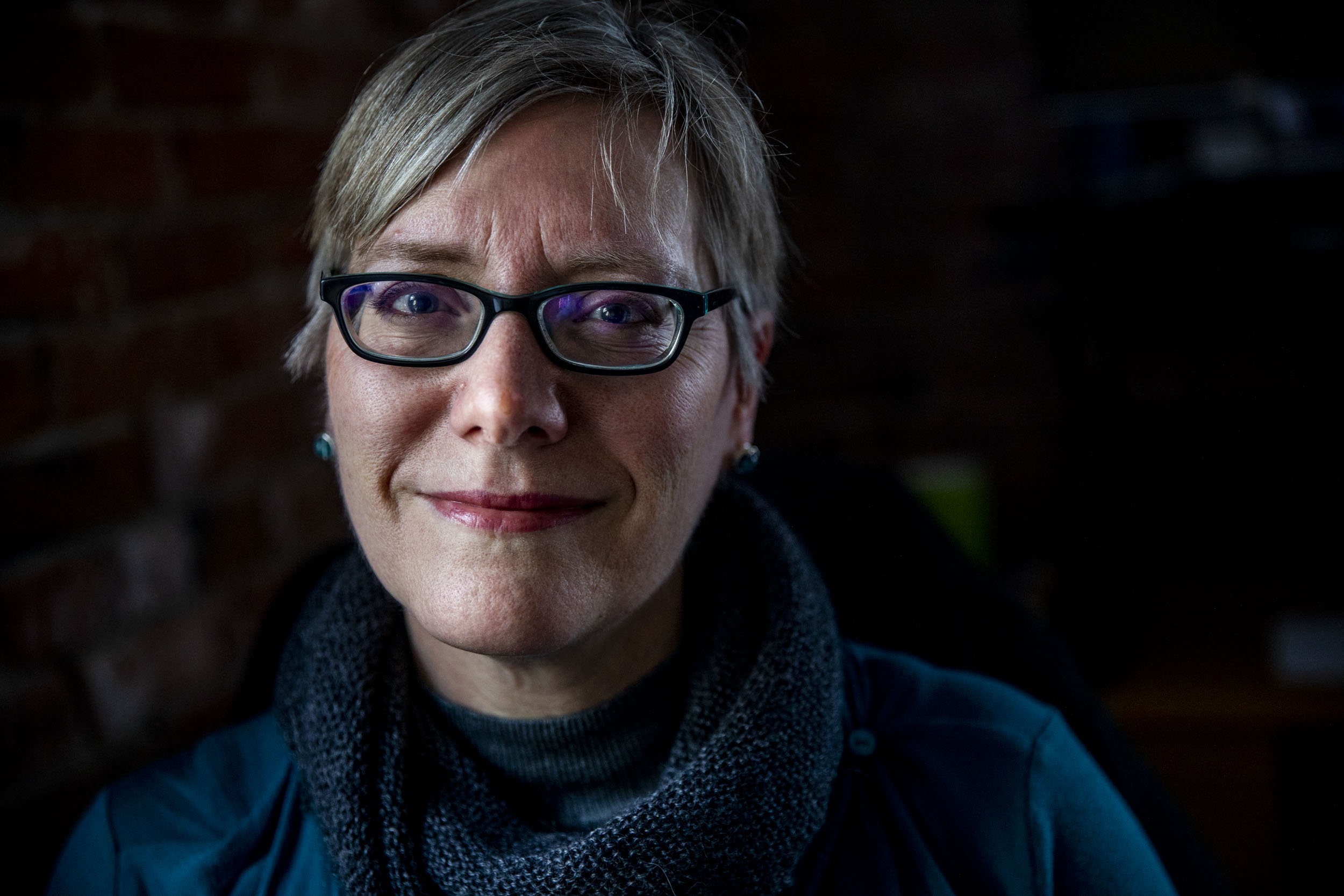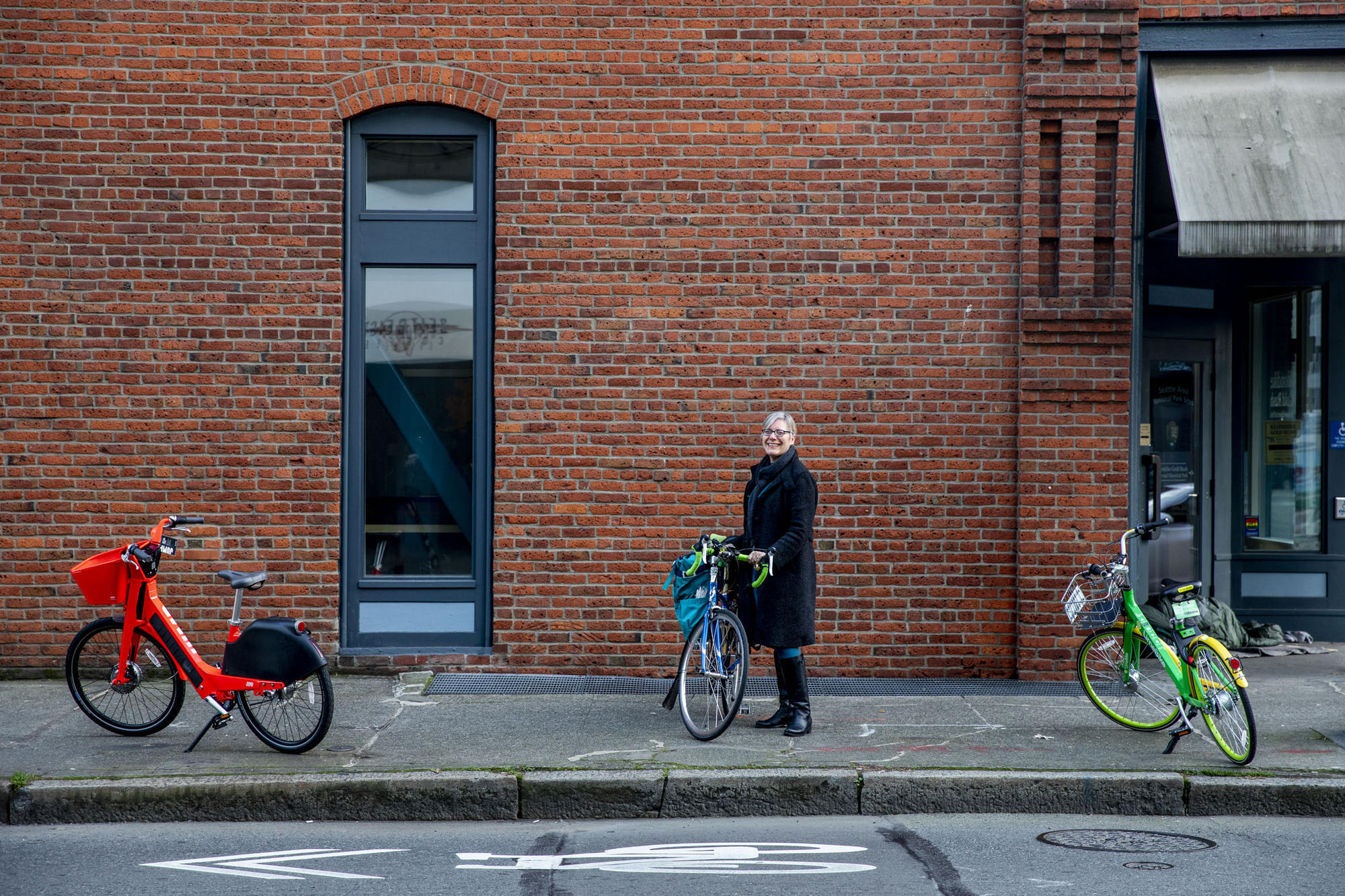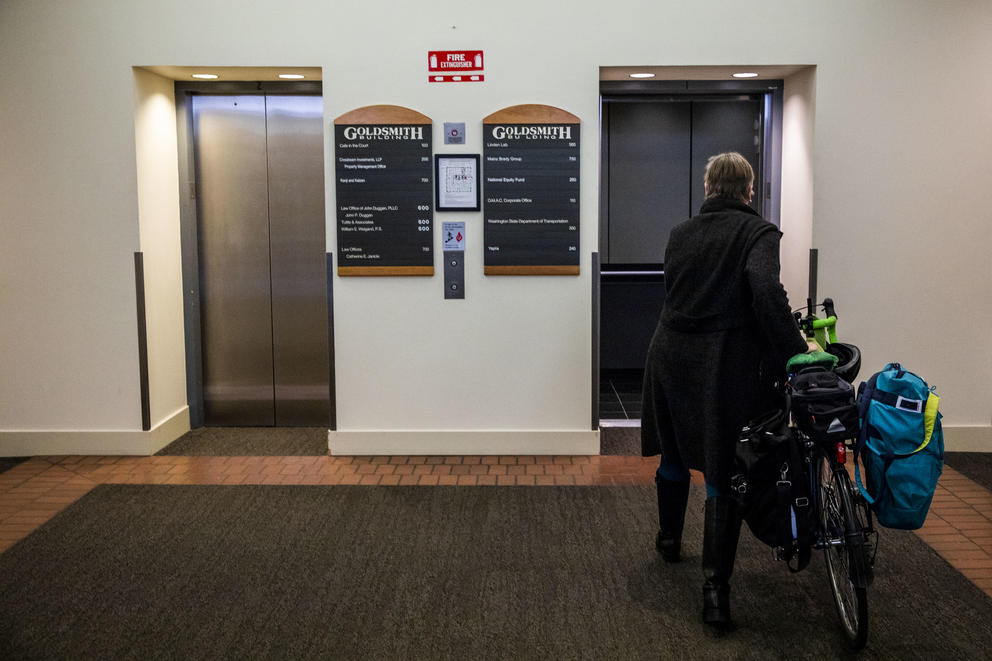But the driver quickly turns left down a side street, and we go straight to continue our 7.5-mile ride through a patchwork of road, bike path and sidewalk leading to Chamberlain’s Pioneer Square office. Our goal is to experience Seattle’s bike infrastructure (good and bad) along her commute, thus rendering tangible the challenges, opportunities and responsibilities of her position as the person in charge of bike infrastructure at the state level.
Chamberlain’s viewpoint mirrors that of the many Washingtonians who believe cycling could save the world, if we let it. Bike commuting is tied to lower carbon emissions, healthier communities and safer and more efficient streets. That’s been nominally accepted as a priority for The Evergreen State for a while: The League of American Bicyclists has designated Washington as its No. 1 Bike-Friendly State for a decade.
But cyclists’ lived experience in Washington doesn’t always reflect the reputation. In Seattle, bike commuting hit a 10-year low in 2017. Meanwhile, bicycle fatalities across the state increased 55 percent from 20 in 2014 to 31 in 2017. Advocates have pushed for decades to complete the Burke-Gilman Trail through Ballard, citing injury rates; while the cross-state Palouse-to-Cascades State Park Trail is still unfinished after nearly 40 years. Seattle has so far failed to deliver on an extensive downtown bike network that was promised in return for a recent tax levy.
People like League of American Bicyclists policy director Ken McLeod are starting to notice.
“That is concerning both from the perspective of safety improvements that have not happened and from the perspective of advocates who supported the levy and now see less of a benefit,” MacLeod says. “The hard facts have not shown improvements [in Washington] in the same way that Oregon, New York, or Virginia have broadly seen improvements in rates of bicycling to work and bicyclist safety.”
Chamberlain joined WSDOT from the bike advocacy world with a mandate to develop a new division that puts active transportation at parity with other modes of transportation, including freight, transit and aviation. For her, the upswing in bike and pedestrian fatalities is particularly worrisome: One of her biggest goals is continuing an ambitious plan to eliminate traffic deaths.
“The safety numbers are going the wrong direction, she says. “In Washington in 2017, 22 percent of [transit] fatalities were people walking and biking, and people walking and biking is not 22 percent of our mode share, whether you think of it in terms of miles or times or number of trips. It is out of proportion to how much we're actually out there, and we're not the worst state in the nation, but we still have to turn the line around.”
As if to illustrate the danger on cue, we embark upon a steep downhill turn with traffic. I hug the shoulder, but Chamberlain takes the lane and chases momentum. She flicks her right hand toward metal grates in the road as she passes to make sure I spot them in my path. I find myself cautiously picking up speed.
Chamberlain became a “bike person” in earnest when she got interested in reducing her carbon footprint while living in Spokane. She ditched a 3.5-mile driving commute for bus rides and walks. “But that's a pretty stiff walk,” Chamberlain says. “And then [Spokane] built a bike lane in front of my house. I joke that I bike because I’m lazy.”
But it didn’t take long for Chamberlain to notice problems with her commute.
“Once I started biking to work in peak traffic, where there are more drivers on the road with me, I started thinking, ‘Well, this needs to be better,’ ” she says. A cycling mentor was on the board of the Bicycle Alliance of Washington (now Washington Bikes), a statewide advocacy group. “She was like, ‘You should join this, they work for better laws.’ And I said, ‘Oh, I'm all about that.’ ”
Bikes took over Chamberlain’s life. She changed careers, moved to Seattle, and ascended to executive director of Washington Bikes in 2012. In 2015, Chamberlain launched the now-annual Washington Bike Summit; later that year, she led the merger between Seattle-based Cascade Bicycle Club and Washington Bikes to create the country’s largest statewide bicycle club.
“Chamberlain is impressive — she manages to always have a pulse on what’s moving, the hot topic and new best practices. I'd describe her as a thought leader in this field,” says Alex Alston, state policy director at Washington Bikes. (WA Bikes is tasked with state-level, statewide policy work, while Cascade handles all of the merged clubs' advocacy work.) “She’s sharp and can communicate the benefits of active transportation for those who may never choose or see themselves as a walker or person who bikes.”
Right now, Chamberlain and Washington Secretary of Transportation Roger Millar are on a mission to make active transportation a viable alternative to using a car. Annual vehicle miles driven in Washington increased 4.8 percent between 2004 and 2016, and a 2017 National Household Travel Survey found that 76.8 percent of car trips were 10 miles or less.
“We drive most [short] trips because we think that's the cheapest most convenient way to do it and we need to change that story,” Millar says. “By giving people alternatives to jumping in their car, it's the cheapest way we have to create capacity on our system for people that need it.”
Millar’s fix centers on the concept of Complete Streets ideology, which asks that all modes of transportation be considered in street design to ensure the safety and efficiency of all users.
After years spent consulting with transportation departments and advocates across the state, Chamberlain identified a concrete goal to get the state closer to Complete Streets: “A complete, connected active transportation network statewide.”
“Connected networks” refer to pathways where people who use each mode of transportation have continuous right-of-way everywhere they need to go in a city, and can then connect to an intercity network. It already works this way for cars, which easily cross the state on designated car infrastructure. Connected networks extend the same privileges to other modes of transit, and help people switch easily between walking, driving, busing, and cycling over the same trip without interrupting commuters who choose different modes of transport — especially active ones.
This helps create safer and more efficient streets for cyclists and pedestrians. Chamberlain says planning has been historically reactive to crashes and focused on the individual roads and crossings where they occur. Instead, she wants traffic planners to make changes that consider their entire trip routes.
"If something is a problem, if that is what's contributing to collisions, you shouldn't just address that at the place where someone's already been hit,” Chamberlain says. “[You should] consider how people end up there in the first place; you might find a better spot to fix or a systemic problem.”
Within a mile of starting our ride toward Pioneer Square, Chamberlain finds three clear examples of why connected networks are important. The narrow street outside the coffee shop where we started doesn’t have a bike lane, but the nature of the street, she says, is such that the broad, bikeable sidewalk is buffered from the road and filled with benches that attract people. There are marked crosswalks to alert drivers to expect people.
“Not all streets need dedicated infrastructure if they’re the right kind of street,” Chamberlain says. The right kind of street, according to Chamberlain, employs engineering techniques like back-in parking, traffic circles and speed bumps to slow down drivers.
That kind of street fails where it connects to other streets. To get to our next big stop, we turn onto the broad road without bike lanes where we almost got sideswiped by the van. This, Chamberlain says, is a street that could use a bike lane: It stretches for a long distance without any speed-reducing features, and offers sidewalks on just one side. Drivers park in the shoulder where cyclists ride; they stand to easily “door” passing cyclists if they fail to look. Meanwhile, to avoid getting doored, cyclists have to move into the lane of traffic.
In ideal complete-streets scenarios, dedicated bike lanes on the right side of a parking lane would keep drivers from interacting with cyclists. Where space is limited, a sidewalk that connects to a bike lane could help. Building lanes like this often means eliminating parking spaces, but experts say more people riding bikes means fewer people who need parking.
For a homerun example of truly bad planning, Chamberlain rides to a nasty intersection of 15 lanes in West Seattle. Beside them are bus stops and a neighborhood with one of the lowest car-ownership-per-household rates in the city, according to Chamberlain. While she’s explaining the dangers of separating a residential area from a bus stop with a four-lane road filled with fast-moving traffic, a pedestrian illustrates the concept by playing a deft game of Frogger just to cross the street. Drivers might legally be required to stop for her, but road design usually puts the most vulnerable road users in positions to take responsibility for avoiding danger.
“That’s legally a crossing!” Chamberlain says, exasperated. “I’m so glad she made it. Look at all of this traffic — it’s not even peak yet.”

Fear of riding in environments like these is precisely why many people don’t bike, Chamberlain says. Surfacing data on where cyclists feel endangered would help planners prioritize projects and lobby for grant money to correct the most dangerous segments of road and connect them to broader safe routes.
Chamberlain is ordering a network analysis of WSDOT’s transportation surfaces — what planners call ‘right of way’ — to rate them all in terms of Bicycle Level Traffic Stress: a 1-to-4 scale where 1 equals “comfortable” and 4 translates to “heart attack.” If you know the bike lane along a 65 mph road is a 4, Chamberlain explains, planners can start envisioning alternatives and connecting them to the broader system: Is the shoulder the only place to ride? Should you get cyclists off the highway and create a bike lane connecting to a regional trail? The test leads to connected-network thinking across departments. With luck and legislation, money follows and Seattle gets a few steps closer to Complete Streets.
“If you come up with the defined network goal, and know where the gaps are and where things need to be better, that becomes the thing you try to put a price tag on,” Chamberlain says. Right now, Chamberlain has requested $5 million for bike and walking projects from Gov. Jay Inslee.
She’s also leading an internal vocabulary shift — in conversation and in documentation — to change assumptions about road safety. The plans are for all WSDOT employees to internalize new messaging that helps contextualize a driver’s responsibility in car-bike crashes. A key example is the idea of using the word “crash” vs. “accident” in documentation.
“Drivers do things, not cars,” Chamberlain says. “ ‘It’s a crash, not an accident’ … that's [what I call] almost invisible incremental institutionalizing. I can't say, ‘Look I changed a word’ and have anybody really care. But every engineer who reads that page and sees that word has to factor that in.”
Near the end of our ride, we cruise under the West Seattle Bridge next to a fishing zone filled with counterintuitive smells from a nearby molasses factory. Chamberlain’s bike-themed necklace glitters in the late-afternoon sun. It’s a gift from the parents of Cooper Jones, a 13-year-old boy killed while cycling. His death led to a series of state-level reforms in 1998 that inspire Chamberlain to this day.
“I think that’s my spot!” Chamberlain yells to me as we roll over a square of smooth new pathway. This is no ordinary block of repaved bike trail: On a July evening in 2016, she broke her elbow here after crashing over uneven pavement. Instead of nursing a grudge against the city or quitting cycling entirely, she blogged about it, warning fellow riders how to respond to similar dangers and get the authorities to respond.
Then she made sure the city fixed it.





